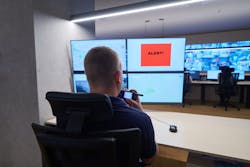Pandemic drives increased adoption of security tech
The Covid-19 pandemic triggered an unparalleled wave of tech adoption for businesses across all industries, the country, as well as around the world – as employees and consultants worked remotely and connected with their team and customers virtually. While much of the technology that was adopted was not really ‘new,’ it was just not yet implemented by many of the businesses that were transformed by the pandemic. Necessity is the mother of technology adoption.
It might therefore be said that what drives technology adoption are major events whether a pandemic, terrorist attack, hurricane, wildfire, cybersecurity incursion, etc., and these events have significantly more impact on advancing adoption than the announcement or roll-out of a cool new technology that generates global buzz. While the adoption of new methods and technologies are accelerated during disruption, the proven value and reliability of these solutions typically continue, expand and improve as we believe will be the case in security.
We saw a dramatic uptick from customers requesting assistance and assessments. A shortage of employees and service provider personnel caused disruption and risk. When it comes to reducing risk and managing the ‘new normal,’ companies knew they had a need, but often were not able to quantify or identify the exact nature. Each were looking for a solution customized to the unique needs of their organization—including site-specific requirements. By leveraging a combination of trained security professionals, data, and cutting-edge technology, companies customized their security solutions to include a variety of technologies ranging from situational awareness and threat intelligence platforms, to remote video and alarm monitoring, to integrated commercial security systems, to web and GPS-based patrol route management.
For large security companies, how to field enough qualified personnel to avoid interruptions to client programs if security professionals tested positive for Covid was a challenge. In this case, ‘necessity was the mother of invention’ as we adapted our manual scheduling processes to a more efficient and faster software assisted methodology. Using some AI-driven software for this specific purpose, much of the time and effort required in keeping positions staffed was solved through the use of an application. In the unfortunate incident of a security professional testing positive and quarantining, our app allowed us to quickly assess who is available, qualified and in proximity to the assignment and let the employee acknowledge their availability and accept the assignment.
There is often a tendency to keep the status quo and continue doing what has been done in the past. Technology sought out and adopted can be disruptive in the workplace and an industry, so necessity has again proven to be the driver of adoption.
Growth of Remote Video Monitoring
The pandemic also generated increased demand from end-users for remote video monitoring services. Every business sector has its benefits for use, which vary widely based upon their objectives. For example, during the pandemic, construction sites and the commercial real estate industry experienced a sudden and dramatic downturn in occupancy with a high volume of vacant or dark facilities. Remote video is incredibly effective, can be rapidly deployed and is flexible to protect commercial real estate or construction sites, especially given many of these sites already have video surveillance systems installed for forensic or local security program purposes. Often the success from a blended security solution utilizing only a few cameras, or a smaller site where officers historically weren’t utilized grows to more cameras or more sites with success and “proof of concept.” For sites lacking the existing infrastructure or systems, we provided solar-powered, cellular-enabled surveillance mounted to poles or on portable trailers that can be delivered, installed, and connected to the monitoring and response center in days, rather than months.
Logistics yards and shipping centers required ways to leverage their video surveillance systems for after-hours, low traffic or unoccupied periods. As organizations learn more about the options available for the use of remote video services and their ability to reduce risk and perhaps even increase productivity, the demand rises. From fast food to convenience stores, and manufacturing to distribution, everyone is looking for an edge and a way to leverage intelligence with their video surveillance camera field of view.
The pandemic has nudged video surveillance into more and more full-time duty. Cameras that were previously only used for surveillance after-hours are increasingly used 24/7 in real time. They provide businesses with the analytics they need to evaluate traffic patterns, people patterns knowing when and where companies want to have resources deployed. In the retail and hospitality sector, with staffing shortages, companies need to ensure their employees are working during peak traffic times.
Video deployment is going beyond security operations and after-hours, to include marketing, logistics and operations. Cameras are being used to establish traffic patterns, customer preferences, staffing requirements, and product availability. For example, a retailer may have cameras deployed for security purposes which, with the assistance of analytic software rules, also allow them to see that their heaviest foot traffic is between 7 to 9 a.m. and that requires the addition of a part-time employee. They can assess which products are the focus of consumer interest, to which areas of the facility customers will gravitate, and make product placement and inventory decisions based on that data.
The development of analytic software solutions has created multiple benefits in business and security intelligence through neural networks powered by AI and deep learning algorithms. AI filtering and additional layers of video analysis both live and forensically applied are center stage this year.
Video surveillance has gone well beyond safety and security to include operations and efficiencies management. These higher applications for video surveillance are due to the integration of increasingly sophisticated AI. We’re able to go beyond keyword-based searches and uncover risky behavior/actions.
We are able to leverage video analytics to spot unsafe practices with AI-driven video content analytics software and track employee compliance with safety regulations. With real-time alerts, we are able to monitor and instill safe habits and behavior.
Blended Solutions Take Off
The pandemic has ushered in several blended solutions whose adoptions have been accelerated due to the pandemic. An example is the heightened usage of cloud-based video surveillance systems that include cameras that stream network video directly to an internet datacenter or series of centers in the cloud with the ability to remotely view live and recorded footage from any fixed or mobile device with an internet connection.
For a long time, we’ve had a recording “box” at the site to which the cameras had to be connected. The server or NVR allows users to view live and recorded images. While technology for the users migrated to the option of connecting remotely or via a mobile application, it was still reliant on a server/recorder being available on site. Hence, if the recorder was damaged, that video may be lost. The proliferation of cloud-based, or hybrid solutions from both new and otherwise more traditional VMS manufacturers and developers is very significant in the industry. Cloud-based systems for several years have been seen as the outliers and advancements have been somewhat limited. The growth and adoption of cloud platforms and hybrid systems has spawned significant advances.
Augmented Reality and the Physical Security Sector
Augmented reality is not just for gamers anymore. The physical security sector is integrating into its platforms for real-world assistance. Let’s say a security professional is walking down an unfamiliar street and needs to find the nearest medical center. The augmented reality system will share icons/hints that points that professional to the closest medical center. Security professionals are now able to intuitively navigate facilities with dynamic maps, arming and disarming intrusion panels and tapping into embedded analytics. They are doing all this through a unified system that includes artificial intelligence (AI) at the backend.
Unmanned Systems Take Off
About four years ago, we recognized the importance that unmanned systems and their technology to detect, control, and direct activity, would have on security programs. Ground-based unmanned systems, robots, faced many challenges in autonomous deployments, because of the need to not only detect, but also report anomalous detections and execute commands either automatously, or by direction from a remote agent. The methods of execution, interface, and reporting were all still in the discovery and planning stages for pilot programs and early adoption.
Although far from “main-stream” and still developing, being part of the rising tide of unmanned systems has resulted in the adoption of practices to assist in the best methods, timing, and implementation of these devices and their software. With the pandemic, the role of unmanned systems in security programs has grown exponentially.
We are deploying unmanned autonomous systems to manufacturing, logistics, shipping, commercial real estate, airport, large retail, and residential communities. Applications include parking lot security, after-hours patrols, detection of persons or vehicles in secure or “closed’ locations. Response to reported events by employees, detection alerts from electronic security systems, such as thermal cameras, capture and reporting of black-listed license plates, and even visitor entry management are all aspects of these types of deployments. Facilities type inspections of areas difficult to access such as roofs and towers, the condition of tanks, pipes, fence lines and pits are also able to be monitored for security and integrity.
While there will always be a need for personnel to be involved in strategic decision-making, situational analysis and security response, machines excel at monotonous, computationally heavy, and sometimes hazardous or difficult-to-reach work. Modern robots and drones help bridge the gap between artificial intelligence and human response. Given their importance, customers are going to want to access the power of robots and drones from someone.
We are able to strategically deploy robotic devices and ensure that the security department can force multiply traditional security with innovative patrolling, surveillance, deterrence, forensics, and communications. These solutions are cost effective and improve situational awareness while augmenting the capabilities of experienced personnel to focus on more strategic tasks and integrating into their existing security systems. Powered with video, audio and sensor technology, cutting-edge algorithms and machine-learning, these robot and drone security solutions help protect people and assets while interacting with them in their workplace.
As more corporate review plans call for bringing employees back to the office, many companies are examining the role of teleworking and offering more flex-work opportunities for some staff. Covid-19 has followed an unpredictable course, and public health guidance has shifted in response to it, necessitating shifts in health and safety practices. Accordingly, the plans are subject to change; are dependent on public health guidance, local health conditions, safety requirements/restrictions; and assume high vaccination rates among the community. Companies have learned – in many cases, the hard way – that preparation must occur in advance of the emergency. Technology will likely play an increasingly prevalent role in threat awareness, emergency response and trackable security metrics.
About the Authors:
Sherman Brawner is Vice President & General Manager at Allied Universal Technology Services. Brawner can be reached at [email protected]. Michael Hanlon is Sr. Director Integrated Security Solutions at Allied Universal Technology Services. Hanlon can be reached at [email protected].
About the Author

Sherman Brawner
Vice President & General Manager at Allied Universal Technology Services
Sherman Brawner is Vice President & General Manager at Allied Universal® Technology Services. Allied Universal is a leading security and facility services company in North America with more than 235,000 employees and revenues over $8.4 billion that provides unparalleled security services and technology solutions. Brawner can be reached at [email protected].

Michael Hanlon
Michael Hanlon
Michael Hanlon is Sr. Director Integrated Security Solutions at Allied Universal Technology Services. Hanlon can be reached at [email protected].
